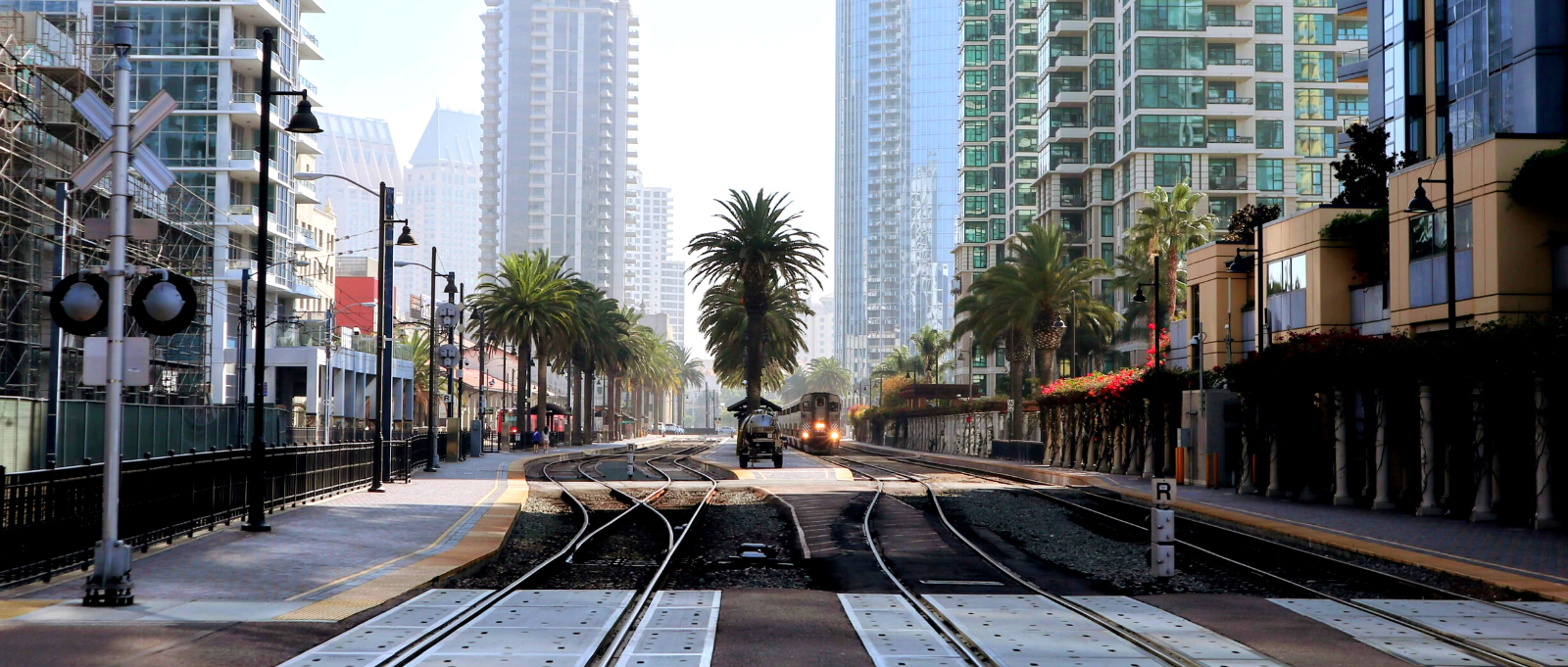November 30, 2021
Topic
Throughout the pandemic, cities made it a lot easier to transform parking spaces—creating opportunities for safer outdoor dining and retail to help businesses recover and prosper while reclaiming public space for people.
This month the City of San Diego took a significant step in codifying this flexible approach by eliminating parking requirements for businesses near transit (within a half mile) or dense residential neighborhoods.
New businesses in those areas would no longer have to provide any parking spaces and existing businesses can now utilize their parking spaces for outdoor dining or extra retail space.
Modeling off of similar changes in Portland and Seattle that have decreased commuter traffic in the city centers, the policy doesn’t mandate the elimination of parking; rather it gives businesses the discretion to determine how much parking they need and how best to use the space.
The step was applauded by environmental and business groups alike (including the Chamber of Commerce) as a strategy that can not only reduce vehicle miles traveled and help the region meet its climate action targets, but also support economic development.
“This is a way to protect the climate while at the same time supporting economic growth,” said Councilmember Stephen Whitburn. “We need to do both to ensure a healthy and vibrant San Diego for future San Diegans.”
This policy is a second step after San Diego eliminated parking requirements for new condominium and apartment complexes near mass transit.
Cities are increasingly recognizing the need to pass these types of policies to reduce car reliance because transportation is the largest source of greenhouse gas emissions in most cities (it makes up more than 50 percent of San Diego’s GHG emissions).
In January the Sacramento City Council voted to approve citywide zoning reforms in its General Plan, including abolishing parking minimums. The City of Berkeley voted to eliminate off-street parking requirements for new developments and implemented parking maximums in transit-rich areas.
San Francisco eliminated parking minimums citywide for all uses in 2018 and established parking maximums as well.
Parking can add significant costs. Eliminating requirements in appropriate areas can allow businesses and housing developers to make better use of the space (with additional housing units or outdoor dining) which will be critical in addressing our housing crisis and helping businesses recover from pandemic impacts. Plus, it can result in less car pollution and reliance. Talk about a win-win-win!
Resource:

Policy Corner
Is California a Climate Leader?
Many have viewed California as a national and international leader in addressing climate change over the past two decades. From AB 32 authored by Assembly Speaker Fabian Nunez in 2006 which embodied the Global Warming Solutions Act to Governor Gavin Newsom’s executive order to phase out the sale of new fossil fueled light duty cars and trucks by 2035, California has been characterized as one of the most aggressive governments on the planet in tackling the daunting prospect of potentially catastrophic alterations to climate conditions.
Among the steps taken at the state level have been:
- The establishment of a cap-and-trade system to reduce greenhouse gas (GHG) emissions from industrial sources and fund hundreds of millions of dollars in climate mitigation projects
- Moving to require 100% of electricity generation to be carbon free by 2045
- Investing hundreds of millions of dollars in subsidizing the development and acquisition of alternative fuel vehicles
Yet, as the United Nations Climate Summit in Glasgow concluded on November 13, a number of voices offered the opinion that California has fallen behind many other national and sub-national jurisdictions around the world. Among those voices were members of the California Legislature attending the conference who argued that the state has lost its mantle as a world leader. State Senator Bob Hertzberg declared it was a “homework club” for the Californians to gather information about what others around the world have done. Senator Bob Wieckowski observed that Washington state has a better cap-and-trade program than California and that we can learn from it. Assembly Speaker Anthony Rendon pointed to Paris as doing more to address extreme heat, the German state of Baden-Wurttemberg as doing more to address transportation, and a number of places in India as having more aggressive goals than California.
So, what may be in the offing as state leaders consider efforts to elevate climate action to a higher level? Those efforts, of course, begin with the implementation of the appropriations approved in this year’s budget of $3.9 billion for clean vehicles, $3.7 billion over three years for climate resilience, $4.6 billion to address the drought and water resilience, and $1.5 billion for wildfire and forest resilience. Beyond those investments, Governor Newsom has ordered the state Department of Conservation and the Air Resources Board to undertake rulemaking to ban fracking by 2024 and to phase out oil extraction by 2045. In addition, AB 1395 by Assemblymember Al Muratsuchi, which would establish the policy for the state to achieve a 90% reduction in GHG emissions from 1990 levels by 2045, remains pending on the Senate floor after having failed to pass before the end of this year’s session. Senator Josh Becker announced that he would introduce legislation when the Legislature reconvenes that would require state government to achieve carbon neutrality by 2035 and another bill to streamline the process for approval of clean energy projects.
Building on this year’s funding for climate-related purposes, more state investment may be possible. The Legislative Analyst has forecast a $31 billion surplus for 2022-23, and one of the categories where money could be allocated would be to infill infrastructure grants (IIFG). Such grants help underwrite the cost of modifying existing infrastructure to accommodate infill housing and other projects. An additional infusion of money for this purpose could help advance badly-needed housing—including affordable housing—while also helping meet climate goals such as more compact development and transit use. The federal Bipartisan Infrastructure Bill that has been signed by President Biden will send additional billions of dollars to California for such purposes as expanding electric charging infrastructure, protecting against wildfires, weatherizing homes, and upgrading and expanding public transit and intercity passenger rail. The federal Build Back Better legislation, if approved, will provide still further billions of dollars to the state for climate-related investments ranging from clean vehicles to smart agriculture.
Climate change presents the greatest social, economic, and environmental challenge of our time. While we must learn from what others are doing, California is still a leader in confronting that challenge.
Board Highlight
 Culver City has just launched MOVE Culver City, a cutting edge project transforming the downtown corridor into a multi-lane thoroughfare for bike, car, bus, and even the new pilot electric minibus CityRide. A recent article in Culver City Crossroads hailed the project:
Culver City has just launched MOVE Culver City, a cutting edge project transforming the downtown corridor into a multi-lane thoroughfare for bike, car, bus, and even the new pilot electric minibus CityRide. A recent article in Culver City Crossroads hailed the project:
“With a dedicated lane for buses and another dedicated lane for bikes, with a minibus offering the crucial connection to transit hubs, and some gorgeous art all the way up the route, mobility is beginning a new chapter in downtown Culver City.”
Read the full article here.





